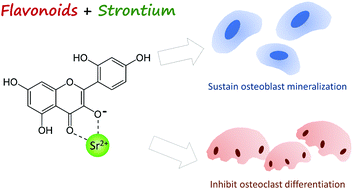Synthesis of Sr–morin complex and its in vitro response: decrease in osteoclast differentiation while sustaining osteoblast mineralization ability
Abstract
Strontium ranelate (SrR) has been used as the ultimate choice for osteoporosis treatment. However, the development of more tolerable and bioactive Sr2+ carriers is still a need. The design of Sr2+-based platforms has moved towards the obtention of anion carriers that can also exhibit a positive effect on bone metabolism. In this sense, we used morin, a natural flavonoid, as a new arrangement for Sr2+ carriage in the synthesis of an Sr2+ complex. It has been claimed that phenolic compounds promote bone health. Therefore, we hypothesized that the association of Sr2+ with morin could improve its anabolic effects. Complexes with the general formula [(C15H9O7)Sr(H2O)2]Cl·3H2O were synthesized and characterized by elemental analysis, thermogravimetry, UV-Vis and infrared absorption spectroscopies and 1H-nuclear magnetic resonance. We showed that the complexation between morin and Sr2+ occurred among the 3-OH and 4C![[double bond, length as m-dash]](https://www.rsc.org/images/entities/char_e001.gif) O groups of morin. Preosteoclasts cultures with the Sr–morin complex exhibited a reduced osteoclast differentiation rate and sustained osteoblast mineralization ability. The response of Sr–morin was higher than that observed for SrR at the same concentration range. Considering the above-mentioned observations, the Sr–morin complex could be an interesting approach to be further exploited not only as an alternative treatment for osteoporosis but also in the design of materials for faster osteointegration.
O groups of morin. Preosteoclasts cultures with the Sr–morin complex exhibited a reduced osteoclast differentiation rate and sustained osteoblast mineralization ability. The response of Sr–morin was higher than that observed for SrR at the same concentration range. Considering the above-mentioned observations, the Sr–morin complex could be an interesting approach to be further exploited not only as an alternative treatment for osteoporosis but also in the design of materials for faster osteointegration.

- This article is part of the themed collections: Celebrating Latin American Talent in Chemistry and Materials and Nano Research in Brazil


 Please wait while we load your content...
Please wait while we load your content...